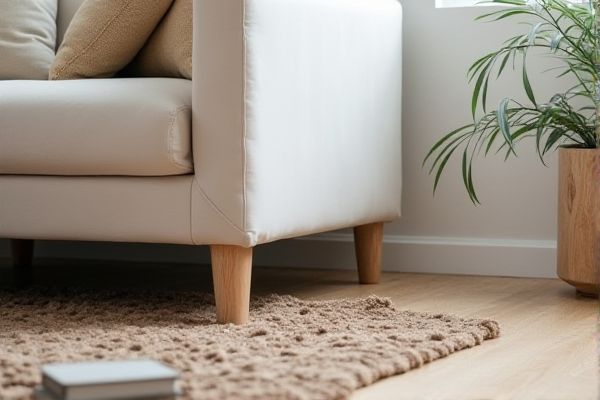
Furniture risers elevate existing furniture to increase height quickly without altering the piece's structure, while adjustable legs provide customizable height and stability by replacing or attaching directly to the furniture base. Discover the advantages of each option to determine which solution best suits Your space and needs by reading the rest of the article.
Table of Comparison
| Feature | Furniture Risers | Adjustable Legs |
|---|---|---|
| Purpose | Raises furniture height by a fixed amount | Allows customizable furniture height adjustment |
| Height Range | Typically fixed (2-6 inches) | Range varies; commonly 2-12 inches adjustable |
| Material | Plastic, wood, or metal | Metal or durable plastic with screw mechanism |
| Installation | Easy; place under furniture legs | Requires mounting or screwing into furniture legs |
| Stability | Stable on flat surfaces but limited adjustment | Highly stable; allows fine height tuning |
| Use Cases | Bedroom bed risers, sofa lifts, furniture elevation | Custom tables, workbenches, cabinets height adjustment |
| Cost | Generally low-cost | Moderate to higher cost depending on type |
| Advantages | Simple, quick setup, affordable | Customizable height, improved ergonomics, versatile |
| Disadvantages | Fixed height, less flexible | Requires installation, higher cost |
Overview of Furniture Risers and Adjustable Legs
Furniture risers elevate the height of your furniture, providing extra storage space and improved ergonomics, while adjustable legs offer customizable height settings for precise leveling on uneven floors. Risers are typically fixed-height blocks made from sturdy materials like plastic or wood, designed for quick installation under bed frames or sofas. Adjustable legs feature screw mechanisms or telescoping designs, allowing fine-tuning that enhances furniture stability and comfort in various room layouts.
Key Differences Between Furniture Risers and Adjustable Legs
Furniture risers elevate your existing furniture by providing a fixed height boost, ideal for increasing clearance or storage space under beds, sofas, or tables. Adjustable legs offer customizable height settings with built-in mechanisms, allowing precise control to suit uneven floors or ergonomic preferences. Choosing between furniture risers and adjustable legs depends on your need for fixed versus flexible height adjustment and the type of furniture you aim to modify.
Pros and Cons of Furniture Risers
Furniture risers offer a simple and cost-effective way to increase the height of your furniture, improving storage space and accessibility. They are easy to install and come in various sizes and materials but may lack the stability and load-bearing capacity compared to adjustable legs. While risers elevate your furniture quickly, they might not provide customizable height options or sleek aesthetics that adjustable legs offer for longer-term solutions.
Pros and Cons of Adjustable Legs
Adjustable legs offer precise height customization, making them ideal for uneven floors and ergonomic needs, with materials ranging from metal to plastic for durability. They can be less stable than fixed risers under heavy loads, requiring periodic adjustments to maintain balance. Installation usually involves screws or clamps, which may be more complex compared to simple slip-on furniture risers.
Materials and Design Options
Furniture risers are typically crafted from sturdy materials such as plastic, wood, or metal, available in stackable designs to easily increase height and provide stability. Adjustable legs, often made from metal or reinforced plastic, feature telescoping mechanisms or screw adjustments for precise height customization and enhanced durability. Both options offer diverse design choices to match various furniture styles, but adjustable legs provide more flexibility for uneven flooring and specific height requirements.
Installation Process Comparison
Furniture risers offer a simple installation process by sliding under the existing legs, requiring no tools or modifications, making them ideal for quick height adjustments. Adjustable legs, however, often involve screwing or mounting, which demands more time, tools, and precision to ensure stability and proper leveling. When considering ease of installation, your choice depends on whether you prefer a fast setup with risers or a more secure, customizable height with adjustable legs.
Cost and Budget Considerations
Furniture risers typically offer a more affordable solution, with prices ranging from $10 to $30 per set, making them ideal for budget-conscious consumers seeking simple height adjustments. Adjustable legs, often priced between $20 and $100 each depending on material and design complexity, provide greater customization but may require a higher upfront investment. Considering long-term durability and installation costs can influence overall budget planning for both options.
Space Efficiency and Versatility
Furniture risers maximize space efficiency by elevating furniture to create additional storage underneath, ideal for small apartments or rooms with limited floor space. Adjustable legs offer superior versatility, allowing height customization to fit various furniture types and accommodate uneven flooring, enhancing ergonomic comfort and design flexibility. Both solutions optimize spatial organization but serve different functional needs based on user preferences and room layout.
Best Use Cases for Each Solution
Furniture risers are ideal for quickly increasing chair, table, or bed height to improve ergonomics and accessibility without permanent modifications. Adjustable legs offer precise height customization and stability, making them perfect for custom furniture designs or workspaces requiring frequent adjustments. Choosing between the two depends on whether flexibility or temporary elevation is the priority.
How to Choose: Furniture Risers or Adjustable Legs?
Choosing between furniture risers and adjustable legs depends on your specific needs for height adjustment, stability, and aesthetic preferences. Furniture risers offer a simple, cost-effective way to elevate beds or sofas for additional storage or ease of access, while adjustable legs provide precise height customization and improved support for tables or cabinets. Consider your furniture type, desired height range, and long-term durability when selecting the best option for your home setup.
 homyna.com
homyna.com